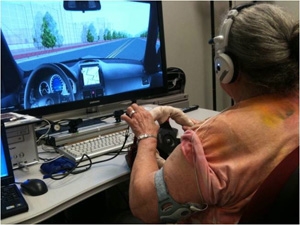Research at Carnegie Mellon University in Pittsburgh and AT&T Labs in Florham Park, New Jersey reveals that a vibrating steering wheel helps keep a driver’s eyes safely on the road by providing an additional means to convey directions from a car’s navigation system. The team’s findings will be presented in June at the International Conference on Pervasive Computing in Newcastle, England.
The study, say the authors, is one of the first to evaluate combinations of audio, visual, and haptic (tactile) feedback for route guidance, and shows different reactions between younger and older drivers. Younger drivers, they found, were less distracted by a navigation system’s display screen when they received haptic feedback from the vibrating steering wheel. For older drivers, however, the haptic feedback reinforced the auditory cues they normally prefer.
Some car makers already offer vibrating steering wheels to alert drivers to road hazards. The haptic steering wheel under development by AT&T, however, is capable of more complex pulsations that can convey more information. Twenty actuators on the rim of the AT&T steering wheel can be fired in any order.
In this study, firing the actuators in a clockwise sequence told a driver to turn right, while a counterclockwise sequence signaled a left turn. With these vibration cues, says Kevin Li, a researcher with AT&T’s user interface group, “we are taking advantage of what people are already familiar with, making them easier to learn.”
One of the Carnegie Mellon researchers, SeungJun Kim and colleagues in the university’s Human-Computer Interaction Institute, have developed ways of measuring the performance, attentiveness, and cognitive load of drivers that involve a suite of sensors. For this study, they added the experimental AT&T steering wheel to their driving simulator (pictured at top).
In the study, researchers were particularly interested in learning whether multi-modal feedback would improve the driving performance of elderly drivers. The number of drivers over the age of 65 is rapidly growing; improving the performance of older drivers despite progressive decay in their vision, hearing and general mobility can help maintain their mobility and independence.
Subjects of the study included 16 drivers age 16 to 36, and 17 drivers over the age of 65. In the Carnegie Mellon simulator, the subjects drove a course that included various traffic lights, stop signs, and pedestrians while the researchers monitored their heart rate, pupil size, blink rate, brain wave activity and other measures of attention and cognitive load.
The researchers found that the proportion of time that a driver’s eyes were off of the road was significantly less with the combination of auditory and haptic feedback than with the audio and visual feedback found in most conventional GPS systems. Older drivers’ eyes were off the road four percent less with auditory and haptic feedback and nine percent less for younger drivers.
Combining audio, visual, and haptic cues significantly reduced eye-off-the-road time for the younger drivers, but not the older drivers. Kim says this difference may have to do with driver preference. Reports from the subjects showed older drivers favor audio feedback while younger drivers rely more on visual feedback.
The researchers also found, however, that combining all three types of feedback did not reduce the cognitive workload of older drivers, which is different for younger drivers. The team concluded that designers of navigation systems for older drivers may need to concentrate on reducing the driver’s cognitive burden rather than resolving issues that concern the driver’s divided attention.
Anind Dey, a professor in the Human-Computer Interaction Institute says, “In combination with our ability to measure cognitive load, we can not only design interfaces that people like and make them more efficient, but that also allow them to more easily focus on their task at hand.”
Read more:
- Intel to Invest $100M in Automotive Electronics R&D
- Ford to Open Silicon Valley Research Lab
- Driver Health Monitors Developed for Passenger Cars
* * *


 RSS - Posts
RSS - Posts
[…] Vibrating Steering Wheel Helps Maintain Driver Attention […]